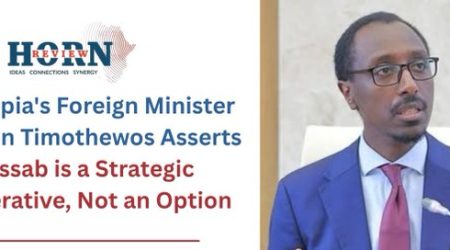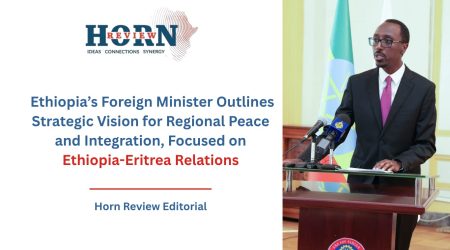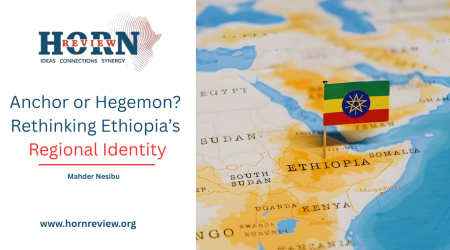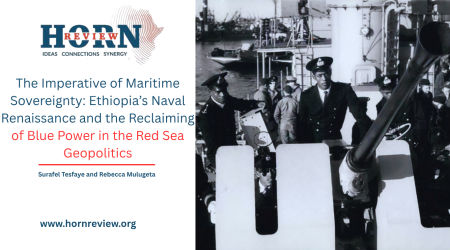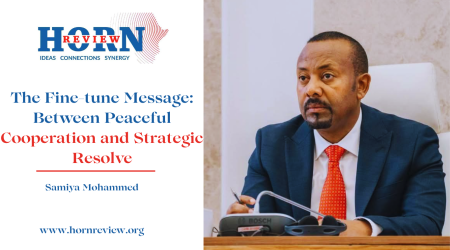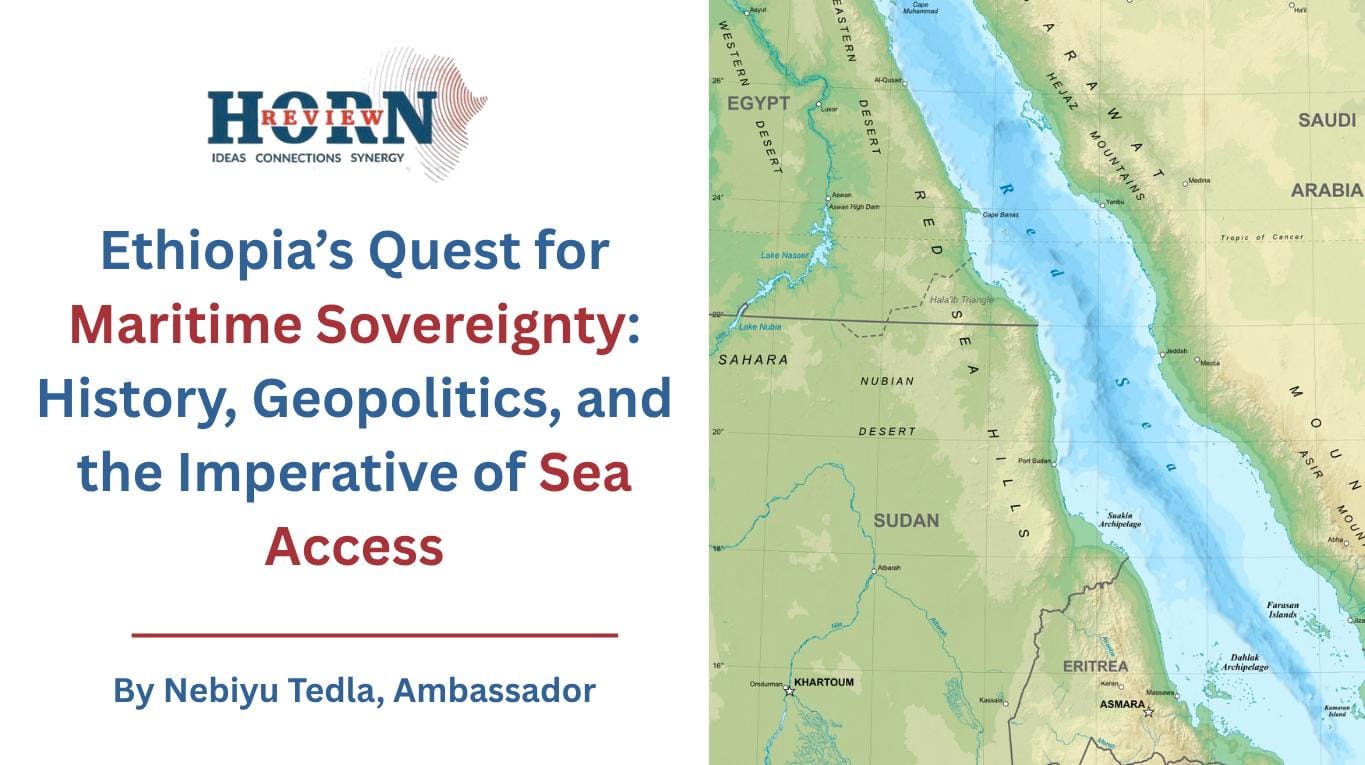
19
Nov
Ethiopia’s Quest for Maritime Sovereignty: History, Geopolitics, and the Imperative of Sea Access
By Nebiyu Tedla , Ambassador
Ethiopia understands perhaps more than any other nation the profound implications of geographic confinement. Once a historic sea power whose ships traversed the Red Sea for centuries, Ethiopia today stands landlocked, an outcome not of destiny but of a political settlement reached in 1993 that severed its natural connection to the maritime world. This rupture reshaped Ethiopia’s economic path, security posture, and diplomatic horizon. It also created an untenable paradox: a nation of more than 130 million people, with one of Africa’s largest economies and militaries, relegated to full dependence on external actors for its commercial lifelines.
It is therefore essential to articulate, with clarity and firmness, why Ethiopia’s pursuit of sovereign maritime access is neither a revisionist project nor a destabilizing ambition. It is a legitimate national imperative rooted in historical justice, economic necessity, and regional stability. As geopolitical contestation intensifies across the Red Sea corridor, one of the world’s most strategically sensitive chokepoints, Ethiopia cannot afford to remain a passive observer while others decide the future of a maritime space that has shaped its identity for millennia.
Ethiopia’s loss of coastal access in 1993 is often misrepresented as an unavoidable component of Eritrea’s independence. In reality, it was a hurried political arrangement concluded in a moment of regional exhaustion, without due consideration for the long-term strategic implications. For centuries prior, Ethiopia exercised sovereign access to the Red Sea, administered internationally recognized ports, and maintained coastal territories such as Assab and Massawa. The Eritrean liberation struggle was not inherently a movement against Ethiopia’s historic presence on the coast; it was rooted in political conditions of earlier decades. Yet the separation produced an outcome that was disproportionate and strategically imbalanced: the permanent disconnection of a vast, ancient state from the sea, without mechanisms such as shared sovereignty, guaranteed maritime corridors, special economic zones, or internationally supported access agreements; arrangements commonly used elsewhere to balance self-determination with strategic necessity.
This political rupture left Ethiopia as the world’s most populous landlocked nation, a condition that no state of its scale and regional significance can reasonably be expected to accept indefinitely. The consequences have been profound. More than 95 percent of Ethiopia’s trade now funnels through a single route -Djibouti, creating a structural vulnerability that places the nation’s economic and security interests at the mercy of external dynamics. Transport costs remain among the highest for any major African economy, eroding competitiveness and slowing industrialization. Energy exports, manufacturing supply chains, and even digital connectivity remain constrained by the absence of sovereign maritime space. For a nation aspiring to anchor continental integration and power the African Continental Free Trade Area, such constraints are unsustainable.
Beyond economics, reliance on the goodwill of neighboring states, though have no problem in principle, it imposes potential security risks. A nation cannot fully guarantee its future when its essential trade routes, humanitarian supplies, and strategic logistics pass through corridors it does not control. The volatility of the Red Sea and Horn of Africa marked by conflicts, shifting alliances, piracy, and great-power competition demands a maritime posture that reflects Ethiopia’s scale, interests, and responsibilities. Permanent landlockedness is incompatible with long-term national security.
Nowhere is Ethiopia’s maritime legacy and contemporary challenge more visible than in Assab. Once a small Afar fishing settlement, Assab was Ethiopia’s primary maritime outlet. By the late twentieth century, it handled nearly two-thirds of Ethiopia’s international trade, supported by infrastructure built through cooperation with the Soviet Union and Yugoslavia, including a major oil refinery inaugurated in 1967. Yet after Eritrea’s independence, the port’s decline was swift. Its population fell, infrastructure deteriorated, and economic activity withered. The port remains vastly underutilized today, disconnected from the economic hinterland that once sustained it. What was historically a mutually beneficial space became a site of lost opportunity.
Any discussion of Assab must acknowledge the Afar people, the indigenous inhabitants of a coastline that spans Eritrea, Ethiopia, and Djibouti. Their cultural and territorial continuity predates all modern borders. Yet in Eritrea, Afar communities have endured systematic marginalization, including restrictions on traditional livelihoods, arbitrary detention, and forced displacement. This situation is not merely a matter of human rights; it has deep geopolitical implications. Ethiopia and Eritrea share not only a boundary but a population whose identity and grievances cross that boundary. The Afar constitute a natural constituency for stability, and underscoring the historical reality that Ethiopia is not an external intruder but a regional actor with organic ties to the Red Sea littoral.
Some also argues that Assab must also be understood in relation to the Dahlak Archipelago. Without the protective depth offered by Dahlak, Assab remains an exposed coastal facility vulnerable to hostile naval power. The islands function as a natural shield—what naval theorists call “unsinkable aircraft carriers.” Any enduring maritime arrangement for Ethiopia must therefore consider a dual reality: access to the coast and the strategic depth required to protect that access. Ethiopia’s decision to rebuild its navy should be understood within this context. It reflects not militarization but strategic maturity a recognition that a nation of Ethiopia’s scale cannot be absent from regional maritime security. Even before securing a permanent homeport, a navy can provide value through partnerships, joint exercises, counter-piracy operations, and maritime domain awareness. It signals Ethiopia’s refusal to accept exclusion from Red Sea governance. It strengthens the region’s collective security architecture. Assab remains the most geographically logical port for Ethiopia, given its proximity to industrial corridors and its existing, though dormant, infrastructure.
Ethiopia’s maritime aspirations have, however, been met with resistance most notably from some quarters, whose recent attempt to frame the Red Sea as the exclusive domain of littoral states aims to delegitimize Ethiopia’s maritime role. This argument is strategically flawed and internally contradictory. Geography has never been a fixed determinant of political rights; borders, access, and sovereignties have constantly evolved through negotiation, treaties, and historical circumstances. If proximity alone defines legitimate claims, then it undermines their own position on the Nile, where Ethiopia source of the vast majority of the river’s flow has long been excluded by colonial-era treaties that favored downstream states.
Ethiopia’s age‑old antagonist’s revival of containment strategies seeking military basing along the African Red Sea coast, attempting to drive wedges between Ethiopia and its neighbors, and merging the geographies of the Nile and Red Sea into a single security sphere reflects a desire to constrain Ethiopia’s rise. Yet history shows the limits of such efforts. Those who have attempted to invade Ethiopia have never lived to see the day. Attempts to halt the Grand Ethiopian Renaissance Dam delayed but did not prevent its completion. Similar efforts to deny Ethiopia maritime access will ultimately fail, not through confrontation but through the force of geopolitical logic.
Ethiopia’s approach to the region stands in sharp contrast. While others politicize geography, Ethiopia seeks geo-economic integration and connectivity. The GERD symbolizes the end of antiquated systems of Nile governance and the emergence of a new Pax Africana grounded in equality and collective benefit. Ethiopia’s vision for the Red Sea and Horn of Africa is not one of spheres of influence but of shared prosperity, where economies are linked, infrastructure is integrated, and security is indivisible. The region cannot be stable if a nation of Ethiopia’s scale is excluded from maritime governance. Nor can littoral states prosper while the hinterland remains constrained and dependent.
Despite external pressures, Ethiopia continues to prioritize diplomatic engagement. Its cooperation with Somalia, its commitment to IGAD and the African Union, and its restraint toward Eritrea despite provocations reflect a responsible regional posture. Ethiopia understands that stability cannot emerge from coercion or exclusion but from negotiated interdependence. A durable settlement that guarantees Ethiopia sovereign maritime access would benefit all Red Sea states. It would reduce the risks of escalation, enhance regional trade, and create predictable frameworks for cooperation on water, energy, and security.
Ethiopia’s return to the sea is not a challenge to any nation. It is the restoration of a historical equilibrium and the fulfillment of a strategic necessity. A nation of ancient civilization, demographic weight, and geoeconomic potential cannot remain indefinitely confined inland due to a settlement forged under the pressures of a bygone era. Ethiopia’s maritime aspiration is peaceful, principled, and inevitable. Whether through sovereign corridors, joint port administration, special economic zones, or mutually beneficial arrangements, Ethiopia will regain its place on the Red Sea responsibly and in partnership with those who seek stability and prosperity in the Horn of Africa.
The world must prepare not for an Ethiopia constrained, but for an Ethiopia reconnected an Ethiopia that anchors regional cooperation, powers continental integration, and resumes its rightful role as a maritime civilization of the Red Sea in a peaceful manner.
Ambassador Nebiyu Tedla Negash is Director General of the Public Diplomacy Directorate General at the Ministry of Foreign Affairs of the Federal Democratic Republic of Ethiopia.



